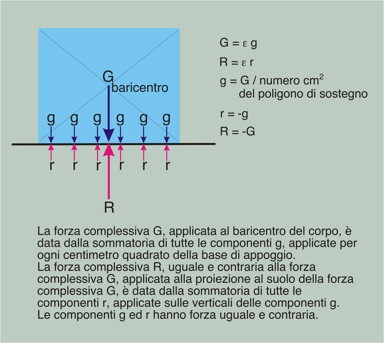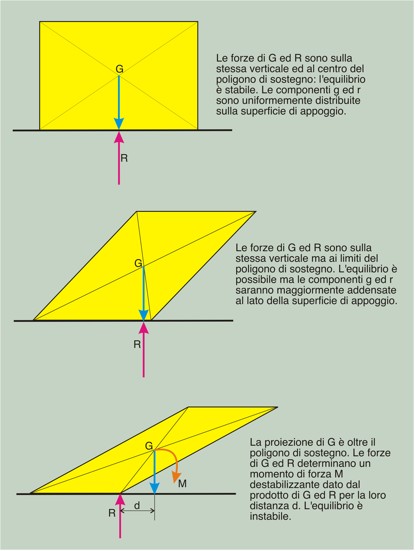Biomechanics of Body Equilibrium
Dr. Mauro Lastrico
Biomechanics: equilibrium of bodies
Dr. Mauro Lastrico, physiotherapist.
Excerpt from:
"Musculoskeletal biomechanics and Mézières method"
Author: Dr. Mauro Lastrico
Marrapese Publisher
Newton's third law of dynamics states: "For every action, there is an equal and opposite reaction," which, in addition to defining inertia force, establishes that a body resting on a solid does not sink toward the center of the earth because the solid itself applies to the body a force equal and opposite to that of its weight.
This means that every body resting on a solid is constantly subjected to two forces: the force of gravity (related to its weight) and the counterforce, equal and opposite, applied by the solid R.
Both forces are applied and distributed over the entire support surface.
The analysis of the equilibrium of a body is possible either by considering the global force G applied to the center of gravity to which a counterforce equal and opposite R reacts (R = -G), or, going into more detail, by considering for each square centimeter the component g, part of G, which acts on the supporting solid. The solid, in turn, reacts with a component r equal and opposite to g (r = -g). G is equal to the sum of all g (G = __g) and R is equal to the sum of all r (R = __r).

A body is defined as being in stable equilibrium when the two forces are on the same vertical and at the center of the support polygon. When G and R are on the same vertical but at the edges of the support polygon, equilibrium is possible but the forces g and r, instead of being distributed, converge at a point. When the two forces are not on the same vertical, a moment of force is created that makes the equilibrium unstable.

When multiple boxes are stacked, each box reacts with the one below. The overall equilibrium will be determined by the mode of alignment. Each single box will have the forces G and R applied and the overall forces of G and R will be given by their sum. The components g and r will be applied and distributed over all support surfaces. If the alignment of the boxes is not on the same vertical but is still such as to allow equilibrium, the forces g and r will be concentrated at certain points, causing compressive structural phenomena.

Every part of the human body has its own center of gravity and the center of gravity of the body is the result of the sum of each of them. To each individual center of gravity the force G and the counterforce R are applied.
If the individual centers of gravity are misaligned, they behave like the boxes in the drawing above: the components g and r may create compressive moments to the articular structures.

Except in clinostasis, human equilibrium is unstable, as the body center of gravity is in continuous movement due to respiratory activity and other variables.
The tonic-postural activity of the muscles, under the control of the extrapyramidal system, is therefore constantly varying in tone in order to keep G and R on the same vertical, if the goal is to maintain the standing position, or to create the moment M, if the goal is movement.
Copyright © 2025 AIFiMM Formazione Mézières Provider E.C.M. n. 1701. All rights reserved.



